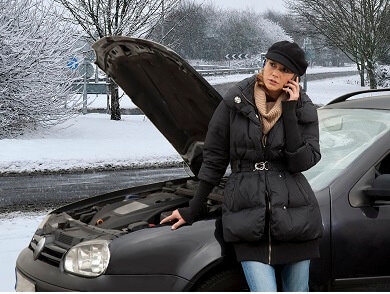Winter Weather: Tips for Driving Safely in Snow and Ice

Before you head off
Road safety chief for the Royal Society for the Prevention of Accidents (RoSPA), Kevin Clinton, said “The most important thing to remember about driving safely in wintry weather is to be prepared. Make sure your vehicle is in good working condition and add enough time for a journey so you are less likely to rush to make up for any delays.”
RoSPA advises drivers to:
- Ensure the lights are clean and working
- Fill windscreen washer reservoir with the correct concentration of screen wash
- Make sure they have a full tank of fuel in case they get stuck
- Check tyres are at the correct pressure and have at least the legal minimum 1.6mm of tread depth. Safety campaigners and tyre experts claim minimum tread depth should ideally be 3mm
- Carry a blanket, shovel, pair of sturdy boots, reflective jacket and a phone charger
- Ensure the heater is blowing warm air before setting off as this will help keep the screen clear
De-icing your car
Nick Reid, of Green Flag breakdown provider, said: “The most effective way of de-icing your windows is still with a proper scraper. This will allow you to shift the ice quickly. Don’t try to de-ice your windows by running your windscreen wipers. All you’ll do is cause excessive wear to the blades.
“Never use boiling water to clear a windscreen, either. It may be very effective at melting the ice or snow but it’s also likely to cause your screen to crack. If you’ve got a small chip or some damage that you may not have noticed, the boiling water will get into it and the sudden expansion will turn that tiny chip into an ever-growing crack.”

Battery checking
Green Flag says the vast majority of breakdowns it attends are due to battery problems. This is made worse by cold weather. The company’s Nick Reid revealed: “Car batteries usually have a lifespan of between five and seven years. But how they’re treated has an effect on how long they’ll last.” If you do a lot of short journeys, your battery may not get the chance to fully recharge itself and won’t last as long. If it’s struggling to turn the engine over, it could be on the way out. The majority of garages will check the health of a battery for free.
Stopping distances in cold-weather driving
According to the Highway Code, it can take up to 10 times the distance to stop in icy conditions. Therefore it makes sense to leave a comfortable gap to the cars in front. Richard Gladman, head of driving standards from the Institute of Advanced Motorists, explained: “You need to triple or quadruple the distance from cars in front of you in icy conditions. If a car has to stop suddenly or worse an accident occurs you will need that extra time to react and stop. Preparation and planning are the keys to worry-free driving in cold weather.
Plan your route carefully. Major routes are likely to be treated with salt and less likely to be icy although this might still form in dips and on bridges. Leave more time for your journey. Respect the conditions and don’t expect your journey to take the same amount of time as normal.”
